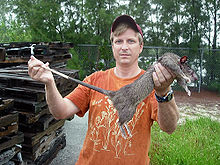
Gambian pouched rat
| Gambian pouched rat | |
|---|---|

| |
| A captive pet | |
|
Scientific classification | |
| Kingdom: | Animalia |
| Phylum: | Chordata |
| Class: | Mammalia |
| Order: | Rodentia |
| Family: | Nesomyidae |
| Genus: | Cricetomys |
| Species: |
C. gambianus
|
| Binomial name | |
|
Cricetomys gambianus
Waterhouse, 1840
| |
The Gambian pouched rat (Cricetomys gambianus), also commonly known as the African giant pouched rat, is a species of nocturnal pouched rat of the giant pouched rat genus Cricetomys, in the family Nesomyidae. It is among the largest muroids in the world, growing to about 0.9 m (3 ft) long, including the tail, which makes up half of its total length. It is widespread in Sub-Saharan Africa, ranging from Senegal to Kenya and from Angola to Mozambique (although it is absent from much of the Democratic Republic of the Congo, where Emin's pouched rat is present) from sea level to 2,000 m (6,600 ft).
The Gambian pouched rat is sometimes kept as a pet, but some have escaped from captivity and become an invasive species in Florida. In the United States, the Centers for Disease Control and Prevention (CDC) and the Food and Drug Administration (FDA) now ban the importation of this species because it is blamed for the 2003 outbreak of monkeypox.
Characteristics
The Gambian pouched rat has very poor eyesight, so it depends on its senses of smell and hearing. Its name comes from the large, hamster-like pouches in its cheeks. It is not a true rat, but is part of an African branch of muroid rodents. It typically weighs between 1.0 and 1.4 kg (2.2 and 3.1 lb). In its native Africa, the pouched rat lives in colonies of up to 20, usually in forests and thickets, but also commonly in termite mounds. It is omnivorous, feeding on vegetables, insects, crabs, snails, and other items, but apparently prefers palm fruits and palm kernels.
It has cheek pouches like a hamster, which allow it to gather up several kilograms of nuts per night for storage underground. It has been known to stuff its pouches so full of date palm nuts so as to be hardly able to squeeze through the entrance of its burrow. The burrow consists of a long passage with side alleys and several chambers, one for sleeping and the others for storage. The Gambian pouched rat reaches sexual maturity at 5–7 months of age. It has up to four litters every nine months, with up to six offspring in each litter. Males are territorial and tend to be aggressive when they encounter one another.
Detection of land mines by scent
A Tanzanian social enterprise founded by two Belgians, APOPO ("Anti-Personnel Landmines Removal Product Development" in English), trains the closely related southern giant pouched rats (Cricetomys ansorgei) to detect land mines and tuberculosis with their highly developed sense of smell. The trained pouched rats are called HeroRATS. The rats are far cheaper to train than mine-detecting dogs; a rat requires US$7,300 for nine months of training, whereas a dog costs about $25,000 for training, but lives about twice as long.
In 2020, a Hero Rat named Magawa (2013–2022) received a People's Dispensary for Sick Animals Gold Medal, the animal equivalent of the George Cross, becoming the first rat to receive the award since the charity began honouring animals in 2003. Before retiring in 2021, Magawa detected 71 landmines and 38 items of unexploded ordnance, clearing over 2,421,880 sq ft (225,000 m2) of land in Cambodia, preventing many injuries and deaths, in his 5-year career. Magawa died from natural causes at the age of 8 in 2022.
Detection of tuberculosis by scent
The Gambian pouched rat is currently being used in experiments at Cornell University to investigate its usefulness in the detection of tuberculosis in human sputum samples. Reports that they are also being used in Mozambique and Tanzania to check tuberculosis test results have proven mildly incorrect: Genetic testing by Watkins shows APOPO's workers are C. ansorgei.
As an invasive species
Gambian pouched rats have become an invasive species on Grassy Key in the Florida Keys, after a private breeder allowed the animals to escape in the 1990s. Starting in 2007, Florida wildlife officials have tried to eradicate it from Grassy Key, but it was still present as of 2014, and has been sighted nearby on Key Largo and in Marathon, Florida.
This outsized African rodent is also believed to be responsible for the 2003 Midwest monkeypox outbreak in the United States, after spreading it to prairie dogs that were purchased as pets. In 2003, the United States' Centers for Disease Control and Prevention (CDC) and Food and Drug Administration (FDA) issued an order preventing the importation of the rodents following the first reported outbreak of monkeypox. Around 20 individuals were affected.
Further reading
- Novak, R.M.; Paradiso, J.L. (1991). Walkers Mammals of the World. Vol. II. Baltimore, MD: Johns Hopkins University Press.
- Perry, N.D.; et al. (2006). "New invasive species in southern Florida: Gambian rat (Cricetomys gambianus)". Journal of Mammalogy. 87 (2): 262–264. doi:10.1644/05-MAMM-A-132RR.1. S2CID 28074023.
- Peterson, A.T.; et al. (2006). "Native range ecology and invasive potential of Cricetomys in North America". Journal of Mammalogy. 87 (3): 427–432. doi:10.1644/05-MAMM-A-133R3.1. S2CID 85265719.
- "Mine rats". News. National Geographic. February 2004. – story regards the use in Africa of giant pouched rats and bees to detect land mines
External links
- "APOPO agency mine clearance". Archived from the original on 2008-08-02.
- "Hero rat". Archived from the original on 2005-12-31.


